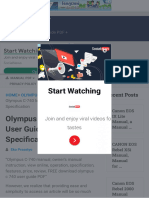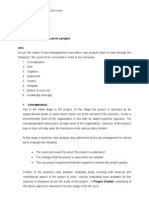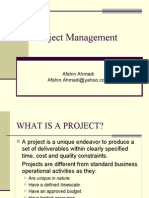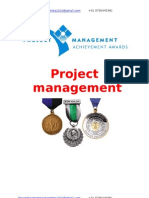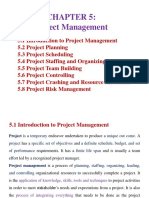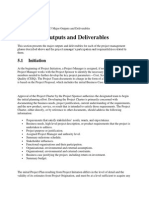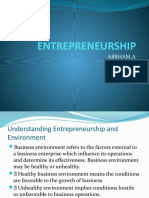100%(1)100% found this document useful (1 vote)
464 viewsProject Management
Project Management
Uploaded by
Ara ArvinthanThe document discusses the key components of a project management plan, including scope, schedule, resources, budget, risks, and communications. It emphasizes the importance of planning in defining objectives, allocating resources, managing expectations, and handling changes. An effective plan considers questions of why, what, how, when and who to coordinate project activities and ensure successful delivery.
Copyright:
© All Rights Reserved
Available Formats
Download as PPT, PDF, TXT or read online from Scribd
Project Management
Project Management
Uploaded by
Ara Arvinthan100%(1)100% found this document useful (1 vote)
464 views82 pagesThe document discusses the key components of a project management plan, including scope, schedule, resources, budget, risks, and communications. It emphasizes the importance of planning in defining objectives, allocating resources, managing expectations, and handling changes. An effective plan considers questions of why, what, how, when and who to coordinate project activities and ensure successful delivery.
Original Description:
ABOUT PROJECT MANAGEMENT
Copyright
© © All Rights Reserved
Available Formats
PPT, PDF, TXT or read online from Scribd
Share this document
Did you find this document useful?
Is this content inappropriate?
The document discusses the key components of a project management plan, including scope, schedule, resources, budget, risks, and communications. It emphasizes the importance of planning in defining objectives, allocating resources, managing expectations, and handling changes. An effective plan considers questions of why, what, how, when and who to coordinate project activities and ensure successful delivery.
Copyright:
© All Rights Reserved
Available Formats
Download as PPT, PDF, TXT or read online from Scribd
Download as ppt, pdf, or txt
100%(1)100% found this document useful (1 vote)
464 views82 pagesProject Management
Project Management
Uploaded by
Ara ArvinthanThe document discusses the key components of a project management plan, including scope, schedule, resources, budget, risks, and communications. It emphasizes the importance of planning in defining objectives, allocating resources, managing expectations, and handling changes. An effective plan considers questions of why, what, how, when and who to coordinate project activities and ensure successful delivery.
Copyright:
© All Rights Reserved
Available Formats
Download as PPT, PDF, TXT or read online from Scribd
Download as ppt, pdf, or txt
You are on page 1of 82
Project Management
3. Project Management Plans
Why
What
How
When
Who
Why
What
How
When
Who
Why is this project happening?
Why now?
Why us?
Why
What
How
When
Who
What solution needs to be put in
place to achieve the goals?
What work needs to happen to build
the solution?
Why
What
How
When
Who
How do we get this solution in place?
How do we know when were done?
Why
What
How
When
Who
When do work activities happen?
What do we need to do first?
Whats last?
Why
What
How
When
Who
Who do we need to deliver this
project successfully?
And what will it cost?
Course objectives
Implement IT project planning and
selection techniques
Appreciate the importance of project
portfolio management
The project management plan
Benefits of planning
What to consider in your plan
Guidelines
Reviewing a plan
The project management plan
Benefits of planning
What to consider in your plan
Guidelines
Reviewing a plan
Plans are useless.
Planning is
indispensible
Dwight Eisenhower
The project management plan
Benefits of planning
What to consider in your plan
Guidelines
Reviewing a plan
http://flickr.com/photos/xabier-martinez/225627841/
Why plan?
Why plan?
http://flickr.com/photos/xabier-martinez/225627841/
The Plan
The Plan
The Plan
The Plan
The Plan
The Plan
The Plan
Changes once you start
http://flickr.com/photos/xabier-martinez/225627841/
The Plan
The Plan
The Plan
The Plan
The Plan
The Plan
The Plan
Changes once you start
Guides you activities
http://flickr.com/photos/xabier-martinez/225627841/
The Plan
The Plan
The Plan
The Plan
The Plan
The Plan
The Plan
Changes once you start
Guides you activities
Makes you think ahead
http://flickr.com/photos/xabier-martinez/225627841/
The Plan
The Plan
The Plan
The Plan
The Plan
The Plan
The Plan
Changes once you start
Guides you activities
Makes you think ahead
Helps you work out who you
need to hire
http://flickr.com/photos/xabier-martinez/225627841/
The Plan
The Plan
The Plan
The Plan
The Plan
The Plan
The Plan
Changes once you start
Guides you activities
Makes you think ahead
Helps you work out who you
need to hire
Works out the timeline and budget
http://flickr.com/photos/xabier-martinez/225627841/
The Plan
The Plan
The Plan
The Plan
The Plan
The Plan
The Plan
Changes once you start
Guides you activities
Makes you think ahead
Helps you work out who you
need to hire
Helps manage expectations
Works out the timeline and budget
http://flickr.com/photos/xabier-martinez/225627841/
The Plan
The Plan
The Plan
The Plan
The Plan
The Plan
The Plan
Changes once you start
Guides you activities
Makes you think ahead
Helps you work out who you
need to hire
Helps manage expectations
Works out the timeline and budget
Helps understand the effects of
changes
http://flickr.com/photos/xabier-martinez/225627841/
The Plan
The Plan
The Plan
The Plan
The Plan
The Plan
The Plan
Changes once you start
Guides you activities
Makes you think ahead
Helps you work out who you
need to hire
Helps manage expectations
Makes sure you are doing the right
thing
Works out the timeline and budget
Helps understand the effects of
changes
The project management plan
Benefits of planning
What to consider in your plan
Guidelines
Reviewing a plan
Who will read it?
What do they need to know?
Do they come in cold?
What is your project going to deliver?
Scope
The work to be done = The target product
Hunt, B. et al. (2003). Project scope statement. Retrieved January 23, 2006
from http://webpages.charter.net/hafox/pm/docs/scope.doc (partial)
What is your project going to deliver?
Definition
The work to be done =?= The target product
What is your project going to deliver?
Change control
The work to be done =?= The target product
What is your project going to deliver?
Value?
The work to be done =?= The target product
The WBS
The right
way
The
wrong
way
Focus on
deliverables
Focus on
processes
Align to
value
Align to
process
stages
Why? Why not?
Figure 5.2 Sample hierarchical WBS organized by phase
(Schwalbe, 2006, p176)
The wrong
way?
Note the
Layers
Table 5.3 Sample tabular WBS
(Schwalbe, 2006, p176)
1.0 Concept
1.1 Evaluate current systems
1.2 Define requirements
1.2.1 Define user requirements
1.2.2 Define content requirements
1.2.3 Define system requirements
1.2.4 Define server owner requirements
1.3 Define specific functionality
1.4 Define risks and risk management approach
1.5 Develop project plan
1.6 Brief Web development team
2.0 Web Site Design
3.0 Web Site Development
4.0 Roll Out
5.0 Support
http://images.google.com.au/images?hl=en&q=wbs&btnG=Search+Images&gbv=2
Document your assumptions
Very little
knowledge
Complete
knowledge
Degree of knowledge over time
OBS
Figure 9.2 Sample Project Organizational Chart
(Schwalbe, 2006, p358)
Task 1
Task 2
Task 3
Task 4
Task 5
Task 6
Person 1 Person 2 Person 3 Person 4
h
t
t
p
:
/
/
w
w
w
.
w
i
n
n
i
n
g
w
i
t
h
a
d
d
.
c
o
m
/
o
r
g
a
n
i
z
a
t
i
o
n
/
Figure 9.6 Sample Resource Histogram
(Schwalbe, 2006, p362)
tools
rasci
(aka raci)
ram
http://makeitstrategic.com/index.php?blog=5&cat=18
r
a
s
c
i
responsible
accountable
supportive
consulted
informed
r
a
m
responsibility
assignment
matrix
http://www.iil.com/freeresources/downloads/UPMM_IIL_Responsibility%20Assignment%20Matrix%20(RAM).doc
Task 1
Task 2
Task 3
Task 4
Task 5
Task 6
Person 1 Person 2 Person 3 Person 4
R
R
R
R
R
R
Figure 9.4 Sample Responsibility Assignment Matrix (RAM)
(Schwalbe, 2006, p360)
OBS: Organizational Breakdown Structure
WBS: Work Breakdown Structure
One and only one person can be accountable. Multiple people
can be responsible and certainly others can be informed and
consulted.
Source: Glen B Alleman, (2007) Responsibility Assignment Matrix, Herding Cats
http://herdingcats.typepad.com/my_weblog/2007/02/responsibility_.html retreived 2/8/08
One and only one person can be accountable.
Multiple people can be responsible and certainly
others can be informed and consulted.
Source: Glen B Alleman, (2007) Responsibility Assignment Matrix, Herding Cats
http://herdingcats.typepad.com/my_weblog/2007/02/responsibility_.html retreived 2/8/08
Project organisations go farther than workers
and work
1. Project Team structure
Project Sponsor
Project Manager
Craig Brown
Working Group:
Design focus
OLA decisions and choices
Formal review & validation of
deliverables
Business input and SME access
Steering Committee:
Governance focus
Approval of project strategy &
plans
Endorsement of key OLA decisions
Final approval of the OLA
Business case and Solution Design
Removal of major roadblocks &
prioritisation
Analysts
Testers
Designer
Change consultants
Working Group
Marketing
Product Management
Legal
Finance
Sales
Customer Service
Steering Committee
Head of Marketing and Sales
Head of Product Management
Head of Customer Service
Head of Finance
Developers
Remember this?
You might break down the work
by phases
Why?
http://flickr.com/photos/pshan427/2382209408/
So now you know what needs to be done
So now you know what needs to be done
and who is going to do it.
So now you know what needs to be done
and who is going to do it.
But what about when?
Schedule
http://www.edwardtufte.com/bboard/q-and-a-fetch-msg?msg_id=000076
Figure 3.3 Sample network diagram (partial)
(Schwalbe, 2006, p211)
Table 3.10 Sample milestone report (partial)
(Schwalbe, 2006, p100)
Figure 3.3 Sample Gantt chart (partial)
(Schwalbe, 2006, p97)
Scope
Resource plan
Schedule
Why
What
How
When
Who
And what will it cost?
Constructing a budget is easy
Sticking to it is hard.
How will you Monitor and
Control the project?
Who needs to know?
Galloway, M. (2004). Status report. Retrieved January 23, 2006 from
http://web.augsburg.edu/~oie/mis376/documents/SR1.doc (partial)
Risk management
Degree of knowledge over time
BetterProjects.net
http://www.betterprojects.net/search?q=risk+101
risks
impact
The project management plan
Benefits of planning
What to consider in your plan
Guidelines
Reviewing a plan
Six-Step Proven Path for Schedule Development
Rudi van den Berg, Pcubed, Inc.
http://www.pcubed.com/Solutions/SolSixStep.asp
The project management plan
Benefits of planning
What to consider in your plan
Guidelines
Reviewing a plan
h
t
t
p
:
/
/
t
h
i
n
h
1
8
0
8
.
f
i
l
e
s
.
w
o
r
d
p
r
e
s
s
.
c
o
m
/
2
0
0
7
/
1
2
/
p
r
o
j
p
l
a
n
_
s
a
m
p
l
e
_
2
0
0
5
0
6
1
0
_
1
4
4
0
2
4
.
p
d
f
You might also like
- Olympus C-740 Manual User Guide and SpecificationDocument12 pagesOlympus C-740 Manual User Guide and Specificationomni007900No ratings yet
- Part 1 Final ProjectDocument31 pagesPart 1 Final ProjectBryanNo ratings yet
- Project ManagementDocument43 pagesProject ManagementArjun Mullu100% (6)
- Project Management Training MaterialDocument55 pagesProject Management Training Materialtulasinad123100% (2)
- It Is Ongoing and RepetitiveDocument49 pagesIt Is Ongoing and RepetitiveGino0% (1)
- Project Management AssignmentsDocument17 pagesProject Management AssignmentsSathyadevan21585% (47)
- Project ManagementDocument60 pagesProject ManagementAfshin100% (71)
- Project Management Fundamentals: Key Concepts and MethodologyFrom EverandProject Management Fundamentals: Key Concepts and MethodologyRating: 5 out of 5 stars5/5 (5)
- Project Management PresentationDocument69 pagesProject Management PresentationSohail Khilji88% (8)
- Basic Project ManagementDocument17 pagesBasic Project ManagementFran JimenezNo ratings yet
- Project Management ProcessesDocument17 pagesProject Management ProcessesAlan KlughammerNo ratings yet
- Project Management For Non-Project ManagersDocument9 pagesProject Management For Non-Project Managerslioubo perezNo ratings yet
- Project - Schedule Management PDFDocument96 pagesProject - Schedule Management PDFRmc Rmc100% (2)
- Project Management Training - SlidesDocument41 pagesProject Management Training - SlidesHadji Javier Tejuco100% (3)
- PMI Project Management PrinciplesDocument37 pagesPMI Project Management Principlestltiede100% (10)
- The Essence of Project ManagementDocument60 pagesThe Essence of Project ManagementbmapiraNo ratings yet
- Project ManagementDocument29 pagesProject ManagementHnin Thiri100% (4)
- Construction Project Management: Additional MaterialsDocument44 pagesConstruction Project Management: Additional MaterialsReza Nugraha100% (1)
- Eddy CurrentDocument19 pagesEddy CurrentSreedhar Patnaik.M100% (3)
- Engr. Jeffrey T. Dellosa Information and Communications Technology (ICT) Center NormisistDocument60 pagesEngr. Jeffrey T. Dellosa Information and Communications Technology (ICT) Center NormisistJomar DadorNo ratings yet
- Project ManagementDocument23 pagesProject Managementsarkar2328100% (6)
- Project Management, Project, Knowledge AreaDocument50 pagesProject Management, Project, Knowledge Areasatishy24275% (4)
- Project ManagementDocument43 pagesProject ManagementWahib WaqasNo ratings yet
- Module 1 Introduction To Project ManagementDocument17 pagesModule 1 Introduction To Project ManagementShernan MabborangNo ratings yet
- Project ManagementDocument91 pagesProject Managementsuleiman_n100% (2)
- Project ManagementDocument87 pagesProject ManagementSmitha K B100% (1)
- PMBOOK 6th SUMMARYDocument92 pagesPMBOOK 6th SUMMARYakurniawan97No ratings yet
- Project ManagementDocument315 pagesProject ManagementAnand Deo80% (10)
- Organizing For Project SuccessDocument49 pagesOrganizing For Project SuccessPerro100% (1)
- Minor ProjectDocument51 pagesMinor ProjectShekhar KumarNo ratings yet
- List The Circumstances Where You Would Base Your Project Management Approach On A Model-Based MethodologyDocument5 pagesList The Circumstances Where You Would Base Your Project Management Approach On A Model-Based MethodologyBranden OxfordNo ratings yet
- Project Management Tools & TechniquesDocument104 pagesProject Management Tools & TechniquesAdib Tawfiq100% (11)
- Project Management Training CurriculumDocument2 pagesProject Management Training CurriculumAnjuNo ratings yet
- Project Management Standards, Tools and Techniques - Group Assignment-1Document12 pagesProject Management Standards, Tools and Techniques - Group Assignment-1NuwanSachithraLansakaraNo ratings yet
- Project Management Teacher NotesDocument22 pagesProject Management Teacher NotesAjaan89% (36)
- Project Management PresentationDocument18 pagesProject Management PresentationNaveen Dsouza100% (1)
- Chapter 8 Net Present Value and Other Investment CriteriaDocument33 pagesChapter 8 Net Present Value and Other Investment CriteriaPaul Adrian BalascanNo ratings yet
- Project Q Exam AnswersDocument8 pagesProject Q Exam AnswersAmir H. Al-ShurafaNo ratings yet
- Project Management 01Document19 pagesProject Management 01ahmed100% (3)
- SPM Chapter 1Document38 pagesSPM Chapter 1Ndoba HakimNo ratings yet
- Project Management Life-Cycle and Processes - FinalDocument49 pagesProject Management Life-Cycle and Processes - FinalchelseapasiahNo ratings yet
- Final Zayredin AssignmentDocument26 pagesFinal Zayredin AssignmentAmanuelNo ratings yet
- Introduction To Project ManagementDocument51 pagesIntroduction To Project ManagementMuhammad FaisalNo ratings yet
- Project ManagementDocument40 pagesProject Managementkebaman1986No ratings yet
- Facilitator Guide - Managing by ProjectDocument50 pagesFacilitator Guide - Managing by ProjectJ Fax100% (1)
- Project Quality Management PDFDocument52 pagesProject Quality Management PDFhabex47671No ratings yet
- What Is Project ManagementDocument14 pagesWhat Is Project Managementआदित्य त्रिपाठी100% (1)
- Project Management LifecycleDocument39 pagesProject Management LifecycleNirav Desai100% (1)
- Introduction To Project ManagementDocument31 pagesIntroduction To Project ManagementWisdom Patrick Enang100% (1)
- Onestop Project - Free PreviewDocument10 pagesOnestop Project - Free PreviewDhanu VijayNo ratings yet
- Information Technology Project ManagementDocument5 pagesInformation Technology Project Managementr15di100% (1)
- Project Management Tools and TechniquesDocument32 pagesProject Management Tools and Techniquesyadavmihir63100% (1)
- Section I: The Project Management Framework: Dr. Saif UllahDocument76 pagesSection I: The Project Management Framework: Dr. Saif UllahTalhaMahmoodNo ratings yet
- Advanced-Project-Managment-Techniques I & II PDFDocument104 pagesAdvanced-Project-Managment-Techniques I & II PDFproject management67% (6)
- Wa0007.Document34 pagesWa0007.Saira frndNo ratings yet
- Project PlaningDocument64 pagesProject Planingsalipm100% (1)
- Introduction To Project Planning & Management: CEM SolutionsDocument30 pagesIntroduction To Project Planning & Management: CEM SolutionsMuhammad Abdul Wajid Rai100% (1)
- Project ManagementDocument27 pagesProject ManagementJohn Johnson100% (2)
- Project Finance Tools and TechniquesDocument104 pagesProject Finance Tools and Techniqueskapenrem2003100% (1)
- 7 Steps to Immense Success in Project ManagementFrom Everand7 Steps to Immense Success in Project ManagementRating: 5 out of 5 stars5/5 (2)
- Download Complete Healthcare Project Management Second Edition Schwalbe Kathy Furlong Dan PDF for All ChaptersDocument50 pagesDownload Complete Healthcare Project Management Second Edition Schwalbe Kathy Furlong Dan PDF for All Chaptersdhaoubuala50% (2)
- Learning Pack 2 Part B Project ManagementDocument9 pagesLearning Pack 2 Part B Project Managementmariamelghazaly2003No ratings yet
- Filariasis: DR Paul T Francis, MD Community Medicine College of Medicine, ZawiaDocument13 pagesFilariasis: DR Paul T Francis, MD Community Medicine College of Medicine, ZawiaAra ArvinthanNo ratings yet
- Water Borne DiseasesDocument34 pagesWater Borne DiseasesAra ArvinthanNo ratings yet
- Alcohol 1Document32 pagesAlcohol 1Ara ArvinthanNo ratings yet
- NGWG GL L Eph G GPLD Fiwghl L Neha : (Acquired Immune Deficiency SyndromeDocument14 pagesNGWG GL L Eph G GPLD Fiwghl L Neha : (Acquired Immune Deficiency SyndromeAra ArvinthanNo ratings yet
- Chicken Soup-Life Love and Learning InspirationsDocument98 pagesChicken Soup-Life Love and Learning InspirationsAra ArvinthanNo ratings yet
- ,dpa RPHPG Gpid, Wjptiu FHG NGHKDocument12 pages,dpa RPHPG Gpid, Wjptiu FHG NGHKAra ArvinthanNo ratings yet
- 3 GR No. 280496-2020-Philippine - Heart - Center - v. - Local - GovernmentDocument10 pages3 GR No. 280496-2020-Philippine - Heart - Center - v. - Local - GovernmentthebeautyinsideNo ratings yet
- Nursing Leadership and Management Practice TestDocument1 pageNursing Leadership and Management Practice TestMikhaela GonzalesNo ratings yet
- Huỳnh Tấn Huy Hoàng - BUSI1637 - Final assignmentDocument21 pagesHuỳnh Tấn Huy Hoàng - BUSI1637 - Final assignmentDream HoangNo ratings yet
- Ere 2Document24 pagesEre 2Adey NgNo ratings yet
- Sample CISSP ResumeDocument4 pagesSample CISSP ResumeAskia MappNo ratings yet
- Ger 3428a Fuels Flexibility HDGTDocument33 pagesGer 3428a Fuels Flexibility HDGTJosemar LopesNo ratings yet
- A264 MsdsDocument11 pagesA264 Msdsjangri1098No ratings yet
- En Banc B.M. No. 2540, September 24, 2013 in Re: Petition To Sign in The Roll of Attorneys Michael A. Medado, Petitioner. Resolution Sereno, C.J.Document3 pagesEn Banc B.M. No. 2540, September 24, 2013 in Re: Petition To Sign in The Roll of Attorneys Michael A. Medado, Petitioner. Resolution Sereno, C.J.Camella AgatepNo ratings yet
- Varian2020x 0Document74 pagesVarian2020x 0mauricio100% (1)
- A Comparative Study On The Preference of Starting Up Traditional or Ecommerce Business of BS Entrepreneurship Students in Ateneo de Davao UniversityDocument38 pagesA Comparative Study On The Preference of Starting Up Traditional or Ecommerce Business of BS Entrepreneurship Students in Ateneo de Davao Universityfloyren valdezNo ratings yet
- Group Assignment - Group 3 - Toyota GSCMDocument36 pagesGroup Assignment - Group 3 - Toyota GSCMBảo Châuu100% (1)
- Stats CH 6 Final ReviewDocument3 pagesStats CH 6 Final ReviewIkequan ScottNo ratings yet
- A1700 Programmable Polyphase Meter: Chapter 3 - HardwareDocument58 pagesA1700 Programmable Polyphase Meter: Chapter 3 - HardwareSong Luy 1 Solar Power PlantNo ratings yet
- E Governance in APDocument7 pagesE Governance in APDonga MailNo ratings yet
- Dai Rang MXL XL L H t5 t10Document6 pagesDai Rang MXL XL L H t5 t10Phúc Lê HoàngNo ratings yet
- 11 - Ir. Dr. Harriezan Ahmad PDFDocument10 pages11 - Ir. Dr. Harriezan Ahmad PDFDerick ChiaNo ratings yet
- Case Study 1Document3 pagesCase Study 1Cyril Mae VillavelezNo ratings yet
- Car-Tycoon-Simulator - FINAL Working FileDocument99 pagesCar-Tycoon-Simulator - FINAL Working FileIrish June TayagNo ratings yet
- 106 - NCR - PT. Tata WisataDocument2 pages106 - NCR - PT. Tata Wisataoperation.pt.tatawisataNo ratings yet
- Reviewer Property LLB - 2A AY 2018-2019Document13 pagesReviewer Property LLB - 2A AY 2018-2019RyoNo ratings yet
- Tax Template Student - JUNE 2016Document4 pagesTax Template Student - JUNE 2016HAFIZUl ASYRAF BIN ABD MALIKNo ratings yet
- Cap 9 - Norbert Leitgeb - Safety of Electromedical Devices - Law - Risks - Opportunities (2010)Document20 pagesCap 9 - Norbert Leitgeb - Safety of Electromedical Devices - Law - Risks - Opportunities (2010)Omar Alejandro FAUSTNo ratings yet
- Arm Microcontroller & Embedded Systems PDFDocument141 pagesArm Microcontroller & Embedded Systems PDFGagan NaiduNo ratings yet
- Mauquf'alaih As A Waqf Accountability Center (Prophetic Social Approach)Document26 pagesMauquf'alaih As A Waqf Accountability Center (Prophetic Social Approach)baehaqi17No ratings yet
- Heart SoothersDocument40 pagesHeart Soothersmukamaflorence551No ratings yet
- Proposal ClimteDocument70 pagesProposal ClimteDevi YantiNo ratings yet
- Dadv Unit1Document40 pagesDadv Unit1movari9313No ratings yet
